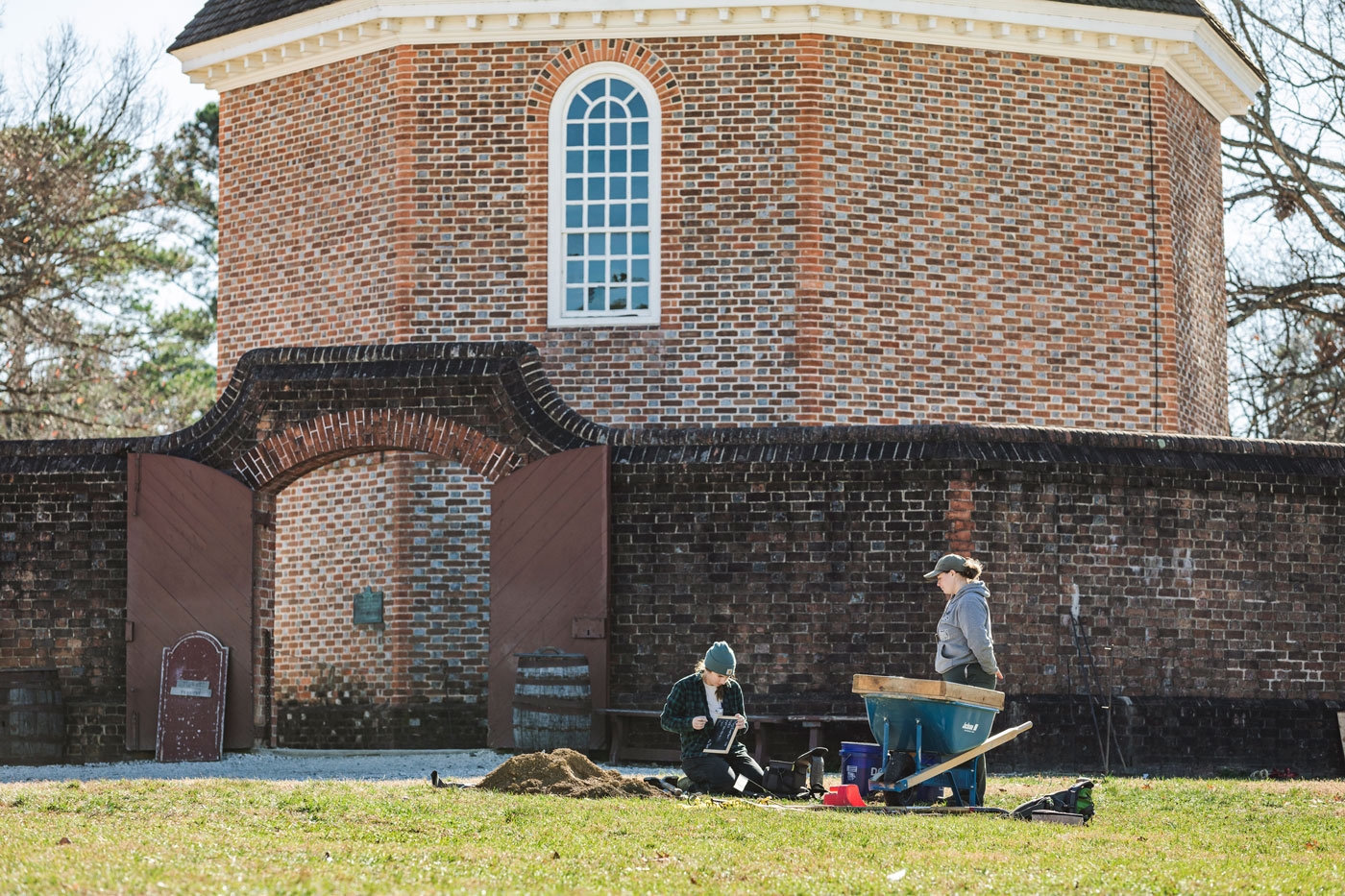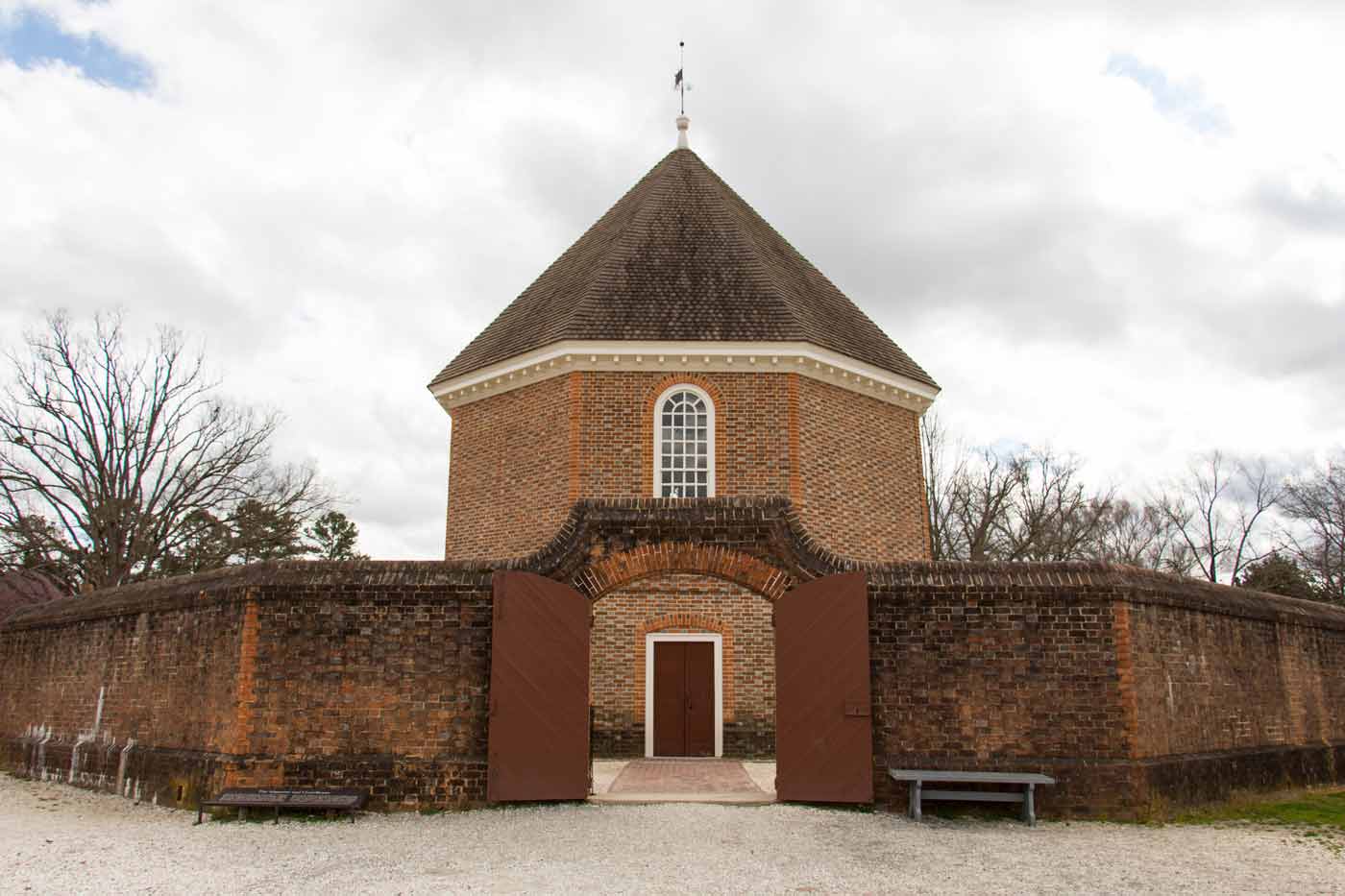In 1934, the historians and archaeologists who were attempting to reconstruct eighteenth-century Williamsburg ran into a brick wall. The perimeter wall that surrounded the old Powder Magazine had been torn down in the mid-1850s, but as they made plans to rebuilt it, they found no contemporary accounts describing how high the wall had been. Built in 1755, they knew only that the brick wall was supposed to be “high and strong.”1
Without firmer evidence, this team relied on a book written by William & Mary professor Lyon G. Tyler, which stated that the wall was “about 10 feet high.”2 Tyler had likely relied on the memories of local residents, though these are not cited. The researchers also used the account of a local reverend, who recalled speaking to an “old woman who could remember the wall as she saw it as a child,” and who insisted that “it was ten feet high.”3 As they understood, this was far from definitive proof of the wall’s height. After all, to a child, everything seems enormous. Lacking better evidence, the Powder Magazine’s perimeter wall was rebuilt at a height of ten feet.

Spurred by a broader effort to restore the Magazine, Colonial Williamsburg’s Department of Architectural Preservation and Research has recently returned to the question of the perimeter wall’s height. They have unearthed new evidence suggesting that the original wall was significantly lower than ten feet.
In 1892, a prominent Williamsburg resident named Johnson Sands wrote to a William & Mary professor describing the wall. Born in 1807, Sands would have seen the wall many, many times as an adult before it was torn down in his late forties. Indeed, his father had worked on repairing the building when it was briefly converted into a church. His account describes “a brick wall 5 or 6 feet high, I am confident it was no more than six feet.”4 Interestingly, Sands’ son later wrote a letter to the Virginia Gazette insisting that his father was adamant that the wall was not higher than eight or nine feet.5 Earlier historians at Colonial Williamsburg were not familiar with these sources.

These accounts of a lower wall match with another piece of evidence that researchers dismissed in 1934. Around 1850, the historian Benson J. Lossing completed a sketch of the Powder Magazine, which depicts a wall much shorter than ten feet.
Other contextual evidence supports the conclusion that the original wall was lower than ten feet. Most other brick walls in Williamsburg and the Chesapeake region were no more than five feet tall, which meant that a six- to eight-foot-tall wall would have seemed “high and strong” to contemporary residents. Moreover, the size of the original wall’s footing (the underground foundation that supports the wall) was similar to those of walls that were five feet tall. A ten-foot wall would have required a wider footing. Finally, evidence about the height of powder magazine walls elsewhere, in Jamaica and Philadelphia, indicates that they were closer to seven feet high.

Colonial Williamsburg aims to present visitors with the most accurate representation of what Williamsburg looked like in the eighteenth century. Since the Powder Magazine was constructed in 1715, notes Colonial Williamsburg Architectural Historian Jennifer Wilkoski, “it has been a powder magazine, market house, Baptist church, dancing school, and stable.” This “changed the building both inside and out,” hiding the original building underneath newer layers. As we try to provide a more accurate version of what this building looked like in the eighteenth century, we draw on evidence, technologies, and techniques unavailable to earlier researchers.
Based on this new information, work will begin this winter to lower the perimeter wall to a height of approximately seven feet. This change will be made alongside additional work to restore the Magazine in time for commemorations of the 250th anniversary of the Gunpowder Incident in 1775.
Further Reading
Sources
- William Waller Hening, The Statues at Large: Being a Collection of All the Laws of Virginia From the First Session of the Legislature in the Year 1619, Vol. 1 (Richmond: Franklin Press, 1819), 528.
- Lyon G. Tyler, Williamsburg: The Old Colonial Capital (Richmond: Whittet & Shepperson, 1907), 222–23.
- Herbert S. Ragland, “Archaeological Report on Excavations and Foundations Around Colonial Powder Magazine Block 12 Building 9,” Colonial Williamsburg Digital Library, https://research.colonialwilliamsburg.org/DigitalLibrary/view/index.cfm?doc=ResearchReports%5CRR0054.xml&highlight=.
- Johnson Sands to Rev. Wharton, January 9, 1892, Special Collections Research Center, Swem Library, College of William & Mary.
- Virginia Gazette, Jan. 13, 1910.




